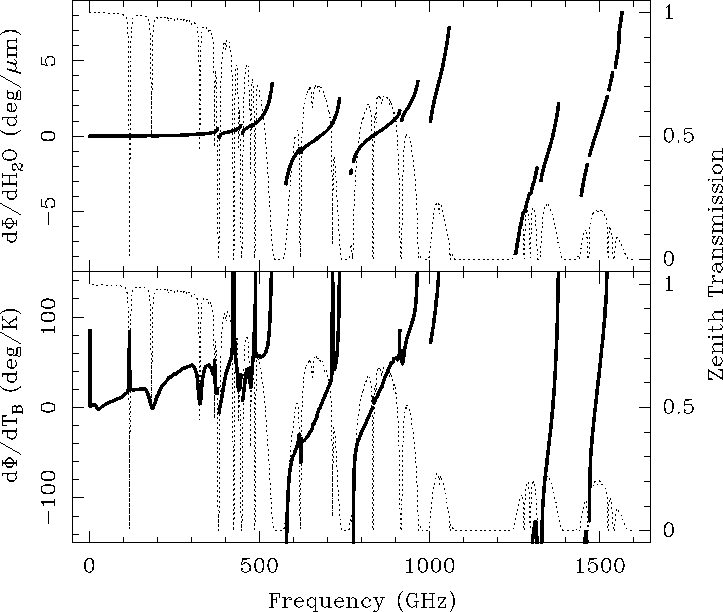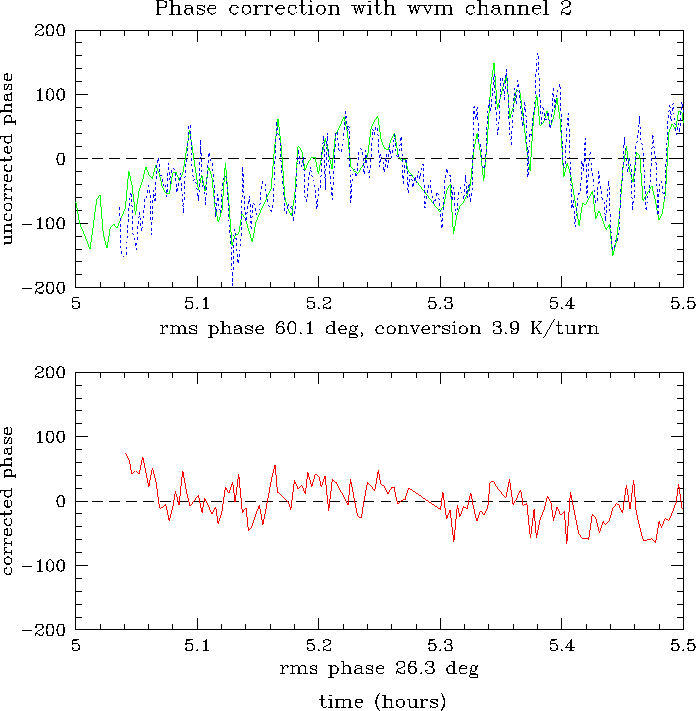The phase measured by an interferometer is the difference in the
arrival times of the signals at the different antennas. The phase
difference contains useful information about the location and
structure of the source, but is also affected by atmospheric
inhomogeneities. The complex dielectric constant fluctuates in
time and in space as the distributions of water droplets, ice
particles, and atmospheric gases suffer variations. In the case of
clear atmosphere (no scatterers present) the main source of phase
delay is water vapor. When there is more water vapor along the
optical path of one of the telescopes, the incoming radiation will
experience an additional delay and the measured phase will
increase by
![]() . With wind the amount of water vapor in
the beam of each telescope will change over time and so will the
detected phase. This phase delay has a resonant behavior as seen
in section 10.2.4. As a result, the source
appears to move around in the sky and, if the signals are
integrated over a period of time which is long compared to the
time scale of the fluctuations (few to tens of seconds),
resolution as well as signal strength will be degraded.
Fluctuations in the dry component of the atmosphere can also
originate phase delays but these are in general less important.
. With wind the amount of water vapor in
the beam of each telescope will change over time and so will the
detected phase. This phase delay has a resonant behavior as seen
in section 10.2.4. As a result, the source
appears to move around in the sky and, if the signals are
integrated over a period of time which is long compared to the
time scale of the fluctuations (few to tens of seconds),
resolution as well as signal strength will be degraded.
Fluctuations in the dry component of the atmosphere can also
originate phase delays but these are in general less important.
 |
Present day radio interferometers
are mostly limited to frequencies below 350 GHz. Phase delay
increases in importance as the frequency increases into
the submillimeter domain because of the strength of the
atmospheric lines involved in both
absorption and dispersion. Using the complex line shape of equation
10.22 we have calculated the derivative of the
phase delay respect to the water vapor column
![]() (this derivative
will be called the differential phase and is provided
in deg/
(this derivative
will be called the differential phase and is provided
in deg/![]() m here). The differential phase
as a function of frequency has been plotted for the Chajnantor
site in Figure 10.5 (where the curve is
restricted to those frequencies where the transmission
is above 10% when the precipitable
water vapor column is 0.3 mm, i.e. very good conditions for single-dish
submillimeter observations). Another useful quantity plotted in
the same figure is the derivate of the phase delay with respect to
the sky brightness temperature (T
m here). The differential phase
as a function of frequency has been plotted for the Chajnantor
site in Figure 10.5 (where the curve is
restricted to those frequencies where the transmission
is above 10% when the precipitable
water vapor column is 0.3 mm, i.e. very good conditions for single-dish
submillimeter observations). Another useful quantity plotted in
the same figure is the derivate of the phase delay with respect to
the sky brightness temperature (T![]() ), since this function
relates the phase correction between two antennas to a measurable
physical parameter (T
), since this function
relates the phase correction between two antennas to a measurable
physical parameter (T![]() ). Note however that whereas
the differential phase described above depends
only on
). Note however that whereas
the differential phase described above depends
only on
![]() , this new quantity depends on
, this new quantity depends on
![]() as well. The curve plotted here corresponds to
as well. The curve plotted here corresponds to
![]() at
at
![]() =0.3mm.
=0.3mm.
As seen in Figure 10.5, the differential phase becomes much
more important in the submillimeter domain than it is at
millimeter wavelengths, so its correct estimation and the
selection of the best means of monitoring water vapor column
differences between different antennas are essential for the
success of ground-based submillimeter interferometry. For example,
the differential phase is 0.0339 deg/![]() m at 230 GHz whereas it
is -0.4665 and 0.2597 deg/
m at 230 GHz whereas it
is -0.4665 and 0.2597 deg/![]() m at 650 and 850 GHz respectively,
roughly an order of magnitude larger.
m at 650 and 850 GHz respectively,
roughly an order of magnitude larger.
 |
There are basically two different phase correction methods:
A) The phase offset due to the atmosphere can be measured directly by observing a calibrator, i.e., a strong point source whose position and hence theoretical phase are well known. Assuming instrumental errors are small the difference between the measured and the theoretical phase gives the phase offset introduced by the atmosphere. The phase offsets, which are interpolated between measurements on the calibrator, are subtracted from the measured phase of an astronomical source.
B) The correction can be determined indirectly by detecting the emission from water molecules and calculating the phase error from the differences in the amounts of water along the paths to the individual antennas using a model as presented on Figure 10.5. There are two different approaches to determine the amount of water vapor: (i) Total Power Method, where the astronomical receivers measure the continuum emission; and (ii) Radiometric Phase Correction, where the emission from water lines is measured by dedicated instruments. So far, radiometers monitoring the 22 GHz and the 183 GHz lines have been built and tested. Receivers at 22 GHz typically have lower noise temperatures than those at 183 GHz, but on (very) dry sites, such as Chajnantor, the 183 GHz monitors will be ideal to measure the optical path with higher accuracy due to the much higher conversion factors from sky brightness temperature in K to optical path length in mm.
Fig. 10.6 shows typical phase correction results in
normal night time weather for Mauna Kea (2.2 mm
![]() ):
The CSO-JCMT interferometer observed bright hydrogen recombination
line maser emission towards the source MWC349 at 354 GHz. The
solid curve in the top plot displays the measured phase after
Doppler correction, it represents the atmospheric phase
fluctuations and some electronic phase noise. The dashed line
shows the phase predicted by the water vapor monitors. The
measured and the predicted phase agree well and their difference
is plotted in the lower graph. Phase correction reduces the rms
phase fluctuations from
):
The CSO-JCMT interferometer observed bright hydrogen recombination
line maser emission towards the source MWC349 at 354 GHz. The
solid curve in the top plot displays the measured phase after
Doppler correction, it represents the atmospheric phase
fluctuations and some electronic phase noise. The dashed line
shows the phase predicted by the water vapor monitors. The
measured and the predicted phase agree well and their difference
is plotted in the lower graph. Phase correction reduces the rms
phase fluctuations from ![]() (140
(140 ![]() m) to
m) to ![]() (60
(60 ![]() m) over 30 minutes. If one would integrate on source for
30 minutes 42% of the astronomical flux would be lost due to
decorrelation, but with phase correction the loss would amount to
only 10%.
m) over 30 minutes. If one would integrate on source for
30 minutes 42% of the astronomical flux would be lost due to
decorrelation, but with phase correction the loss would amount to
only 10%.